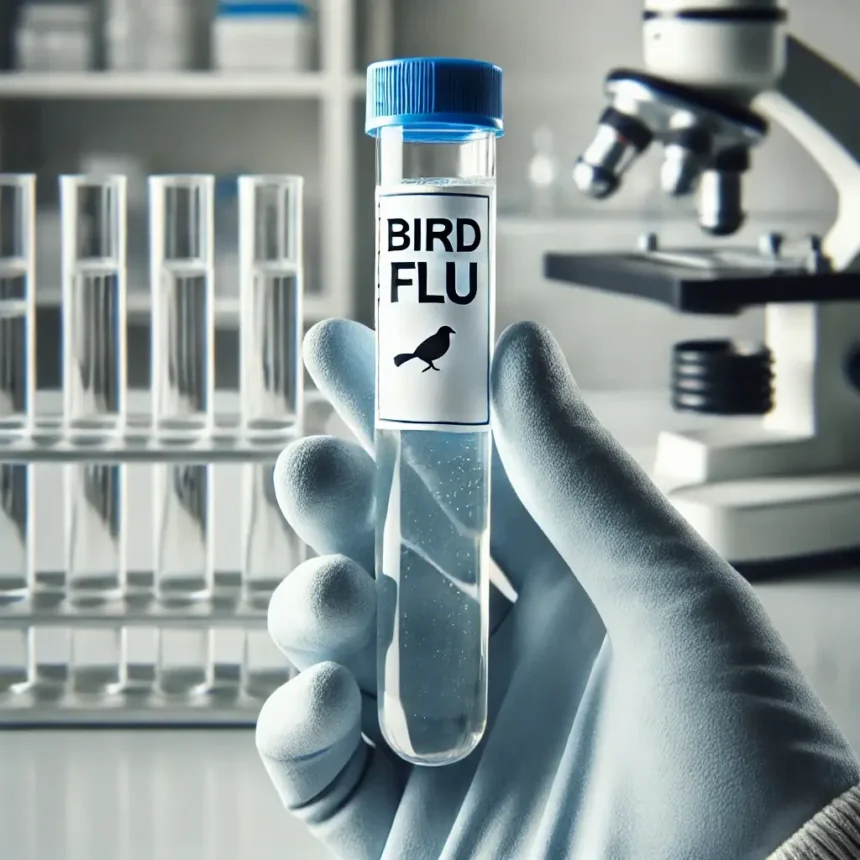At a Glance
- The US confirms its first human death from bird flu (H5N1).
- The deceased was exposed to infected poultry.
- Learn about its implications, risks, and prevention measures.
Explore TN HEADLINES24 insights and share your opinion in our readers’ section.
Synopsis
The bird flu, or avian influenza, has now claimed its first human life in the United States. This alarming development has raised concerns about its potential spread, human-to-human transmission risks, and its impact on public health. In this article, TN HEADLINES24 dives deep into what bird flu is, why this case is significant, and what precautions can be taken to prevent a larger crisis.
How the US Reported Its First Bird Flu Death: Key Takeaways
The Louisiana Department of Health confirmed on Monday that the United States has recorded its first human death from the H5N1 bird flu. This incident has raised public health concerns as experts assess the implications of this fatality. Below, we provide detailed information about the case, the circumstances surrounding the infection, and what it means for public health efforts moving forward.
Details of the Case
The patient, who was over the age of 65, had underlying medical conditions that may have contributed to the severity of the illness. According to officials, the patient was exposed to a combination of backyard chickens and wild birds, both of which are known to harbor the H5N1 virus.
- Exposure Source: The patient had close contact with infected poultry and wild birds, possibly inhaling particles containing the virus or coming into direct contact with contaminated surfaces.
- Health Condition: Being an older adult with pre-existing health conditions, the patient’s immune system may have been compromised, making them more vulnerable to severe complications.
- Hospitalization: After showing symptoms such as severe respiratory distress, the patient was hospitalized. Despite medical intervention, the virus proved fatal.
What is H5N1 Bird Flu?
H5N1, also known as bird flu, is a type of flu virus that mainly affects birds. In rare cases, it can spread to humans. The virus is highly contagious among birds and can be transmitted to people through direct contact with infected birds or their droppings. Human cases are often severe, with over 50% of those infected dying. The virus doesn’t spread easily from person to person. However, it’s important to be cautious when handling birds or poultry in areas where the virus is active.
- Direct contact with infected birds (alive or dead).
- Exposure to contaminated environments, such as poultry farms or live bird markets.
- Handling infected poultry products without proper precautions.
While human-to-human transmission remains rare, the emergence of cases in humans is closely monitored because viral mutations could potentially lead to a pandemic.
Significance of the First US Death
This incident is significant for several reasons:
1. Increased Surveillance is Needed
The death highlights the need for rigorous monitoring of backyard poultry farms and wild bird populations, particularly in regions like Louisiana, where close interaction with birds is common.
2. Vulnerable Groups at Higher Risk
Older adults and individuals with underlying conditions are more susceptible to severe outcomes. Public health campaigns should focus on educating these groups about preventive measures.
3. Threat of Mutation
Though H5N1 has not yet shown consistent human-to-human transmission, any mutation in the virus could pose a serious global health risk. Health agencies must remain vigilant and prepared for any developments.
How Did the Virus Spread to Backyard Poultry?
H5N1 is often transmitted to domestic poultry through contact with migratory wild birds, which act as natural carriers of the virus. Once introduced, the virus spreads rapidly among chickens, ducks, and other farmed birds, making backyard poultry a potential hotspot for infections.
Symptoms of H5N1 in Humans
Human symptoms typically appear 2-10 days after exposure and can range from mild to severe, including:
- Fever and chills
- Cough and sore throat
- Shortness of breath
- Muscle aches
- Severe respiratory distress (in advanced stages)
In fatal cases, complications such as pneumonia and organ failure are common.
Preventive Measures for Individuals
To reduce the risk of contracting bird flu, individuals are advised to:
- Avoid Direct Contact: Stay away from sick or dead birds, especially in affected areas.
- Wear Protective Gear: Use gloves and masks if handling birds or cleaning coops.
- Cook Poultry Thoroughly: Heat kills the virus; ensure all poultry and eggs are cooked to an internal temperature of 165°F (74°C).
- Practice Good Hygiene: Wash hands frequently, especially after handling birds or visiting live markets.
Public Health Response
State and Federal Measures
The Louisiana Department of Health has initiated investigations to trace the exact source of the infection and prevent further cases.
CDC (Centers for Disease Control and Prevention) is closely monitoring the situation and has urged states to ramp up avian flu surveillance in both humans and animals.
Global Cooperation
The case underscores the importance of international collaboration to track and contain bird flu outbreaks. Health agencies, including the World Health Organization (WHO), are working together to study the virus and develop better vaccines.
Vaccines and Antiviral Medications
Although there is no universal vaccine for H5N1 in humans, antiviral drugs such as oseltamivir (Tamiflu) and zanamivir (Relenza) can reduce the severity of symptoms if administered early.
TN HEADLINES24 INSIGHTS
At TN HEADLINES24, we believe this incident underscores the need for collective action and awareness in preventing the spread of diseases like H5N1. Here are some key points to consider:
- Raising awareness among poultry farmers: Educating those who work with animals on proper biosecurity measures is essential in reducing the risk of transmission.
- Improving healthcare access for vulnerable groups: Ensuring that healthcare services are readily available can help detect and manage outbreaks early, minimizing their impact.
- Investing in research: Supporting studies that focus on understanding how the virus evolves and spreads will help us stay ahead of potential threats.
By focusing on these areas, we can strengthen our preparedness and protect public health more effectively. Working together will help build a safer, more resilient future for all.
TN HEADLINES24 READERS’ INSIGHTS
What’s your take on this tragic development?
Should there be stricter regulations for backyard poultry?
Do you think global health agencies are prepared for a potential bird flu pandemic?
Share your thoughts in the comments or email us at insights@tnheadlines24.com!
TN HEADLINES24 BOTTOM LINE
The first US death from H5N1 bird flu marks a pivotal moment for public health in the country. While the risk of widespread human infection remains low for now, vigilance and preventive measures are crucial to mitigating future risks. As this case shows, the virus can have devastating effects, especially for vulnerable individuals.
Stay informed and stay safe—follow TN HEADLINES24 for more updates on global health developments.
Please visit authoritative information related to H5N1, biosecurity practices, healthcare access, and virus research.
https://www.who.int/influenza/en/
https://www.who.int/influenza/en/
https://www.cdc.gov/flu/avianflu/index.htm
For more detailed information, visit the CDC’s Bird Flu Guidelines
https://www.cdc.gov/flu/avianflu/index.htm
For more insights on HMPV please also visit at: TN HEADLINES24
TN HEADLINES24 QUIZ | TEST YOURSELF
1. What is the age group of the first US bird flu victim?
a) Below 50
b) Between 50-65
c) Over 65
d) Under 18
2. How did the patient get exposed to the virus?
a) Through air pollution
b) Direct contact with backyard chickens and wild birds
c) Consuming undercooked poultry
d) Human-to-human transmission
3. What underlying factor increased the patient’s risk?
a) Strong immune system
b) Underlying medical conditions
c) High physical activity
d) Lack of exposure to birds
4. What does H5N1 primarily affect?
a) Mammals
b) Birds
c) Reptiles
d) Amphibians
5. What is the estimated fatality rate of H5N1 in humans?
a) 10%
b) 25%
c) Over 50%
d) Less than 1%
6. How does H5N1 spread to domestic poultry?
a) Through wild birds’ migration
b) Contaminated water supplies
c) Infected feed
d) All of the above
7. Which organization is monitoring H5N1 globally?
a) WHO
b) UNESCO
c) UNICEF
d) WTO
8. What is one common symptom of H5N1 in humans?
a) Muscle weakness
b) Fever and chills
c) Skin rash
d) Vision loss
9. Which region reported the first US bird flu death?
a) Texas
b) Louisiana
c) Florida
d) California
10. What is a preventive measure against H5N1?
a) Eating raw eggs
b) Wearing protective gear around birds
c) Ignoring symptoms
d) Cooking poultry partially
TN HEADLINES24 | VOCABULARY CHALLENGE
1. What does “zoonotic” refer to?
a) A type of animal shelter
b) Diseases that transfer from animals to humans
c) A wild bird species
d) A viral mutation
2. Define “avian”.
a) Related to water
b) Related to mammals
c) Related to birds
d) Related to agriculture
3. What does “fatality” mean?
a) A type of treatment
b) Risk of illness
c) Death caused by a disease
d) Animal infections
4. What is the meaning of “culled”?
a) Selectively removed or killed
b) Trained for farming
c) Released into the wild
d) Separated for breeding
5. What does “mutation” refer to in the article?
a) Viral genetic changes
b) Animal reproduction
c) Bird migration
d) A type of vaccine
6. Define “pandemic”.
a) A regional disease outbreak
b) A global disease outbreak
c) Seasonal illness spread
d) Poultry disease spread
7. What does “surveillance” mean in health terms?
a) Ignoring outbreaks
b) Monitoring and tracking diseases
c) Removing infected animals
d) Researching vaccine effects
8. What does “implications” mean?
a) Outcomes or consequences
b) Causes of diseases
c) Preventive measures
d) Farming techniques
9. Define “precautionary”.
a) Proactive preventive measures
b) Unrelated steps
c) Delayed actions
d) Emergency treatment
10. What does “resonating” mean in communication?
a) Creating confusion
b) Connecting deeply with the audience
c) Ignoring feedback
d) Expressing anger
Answers to Quizzes
TN HEADLINES24 QUIZ | TEST YOURSELF
1-c, 2-b, 3-b, 4-b, 5-c, 6-a, 7-a, 8-b, 9-b, 10-b
TN HEADLINES24 | VOCABULARY CHALLENGE
1-b, 2-c, 3-c, 4-a, 5-a, 6-b, 7-b, 8-a, 9-a, 10-b
Disclaimer
The information in this article is for general knowledge purposes only and should not be interpreted as professional or medical advice. TN HEADLINES24 does not guarantee the accuracy, reliability, or completeness of the information presented. Consult qualified health experts for advice on bird flu and related concerns. External links in this article are provided for reference, and TN HEADLINES24 is not responsible for their content. The views expressed in this article are solely those of the author and do not necessarily reflect TN HEADLINES24‘s editorial stance. Readers are encouraged to conduct their research.




